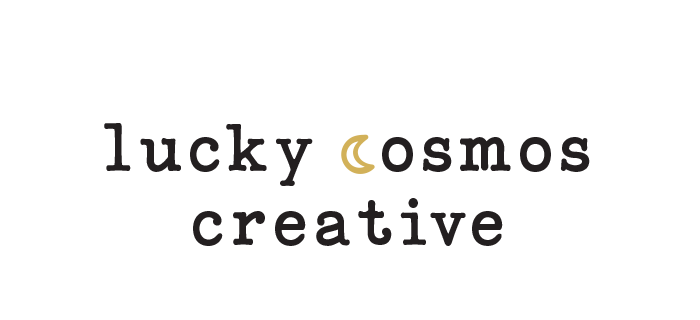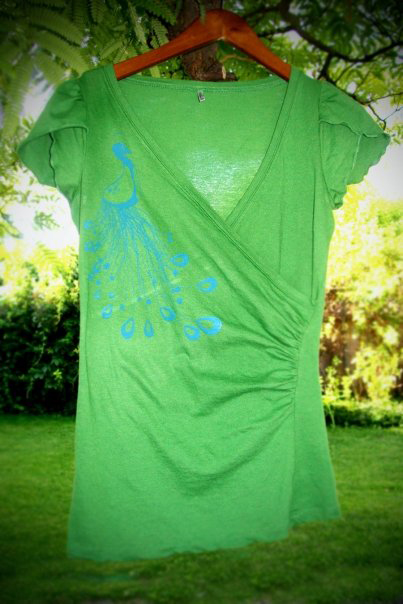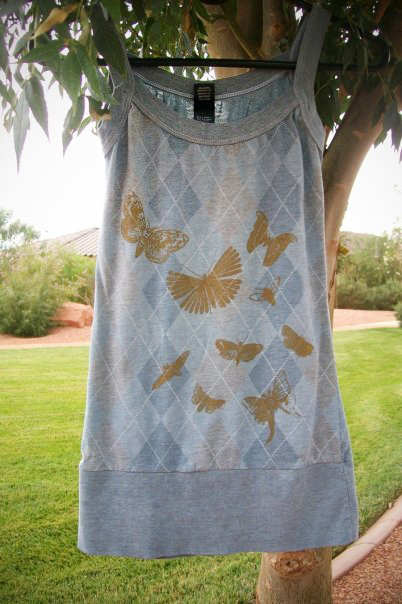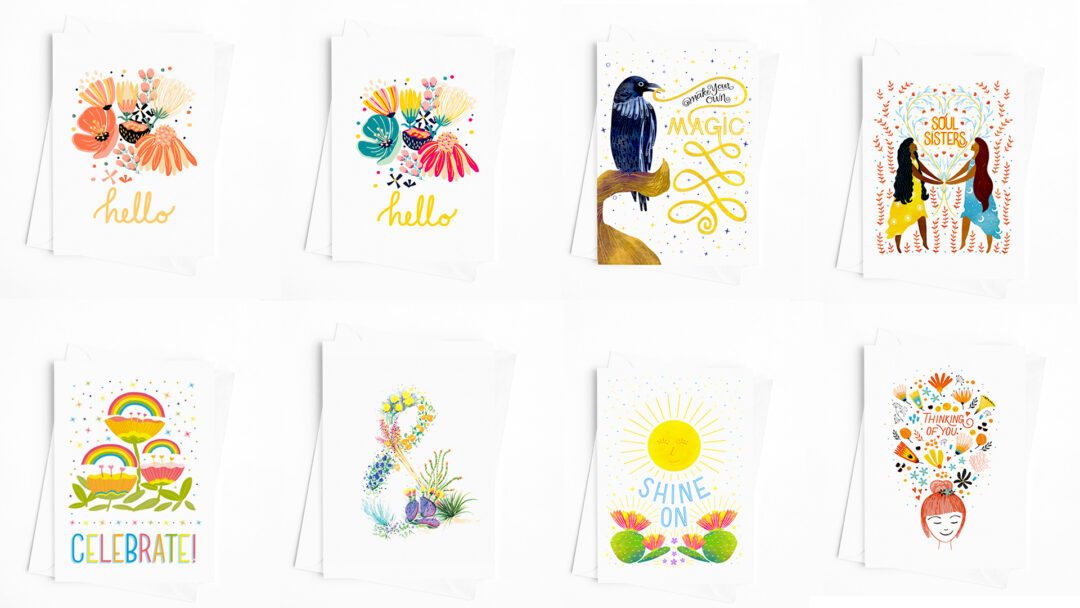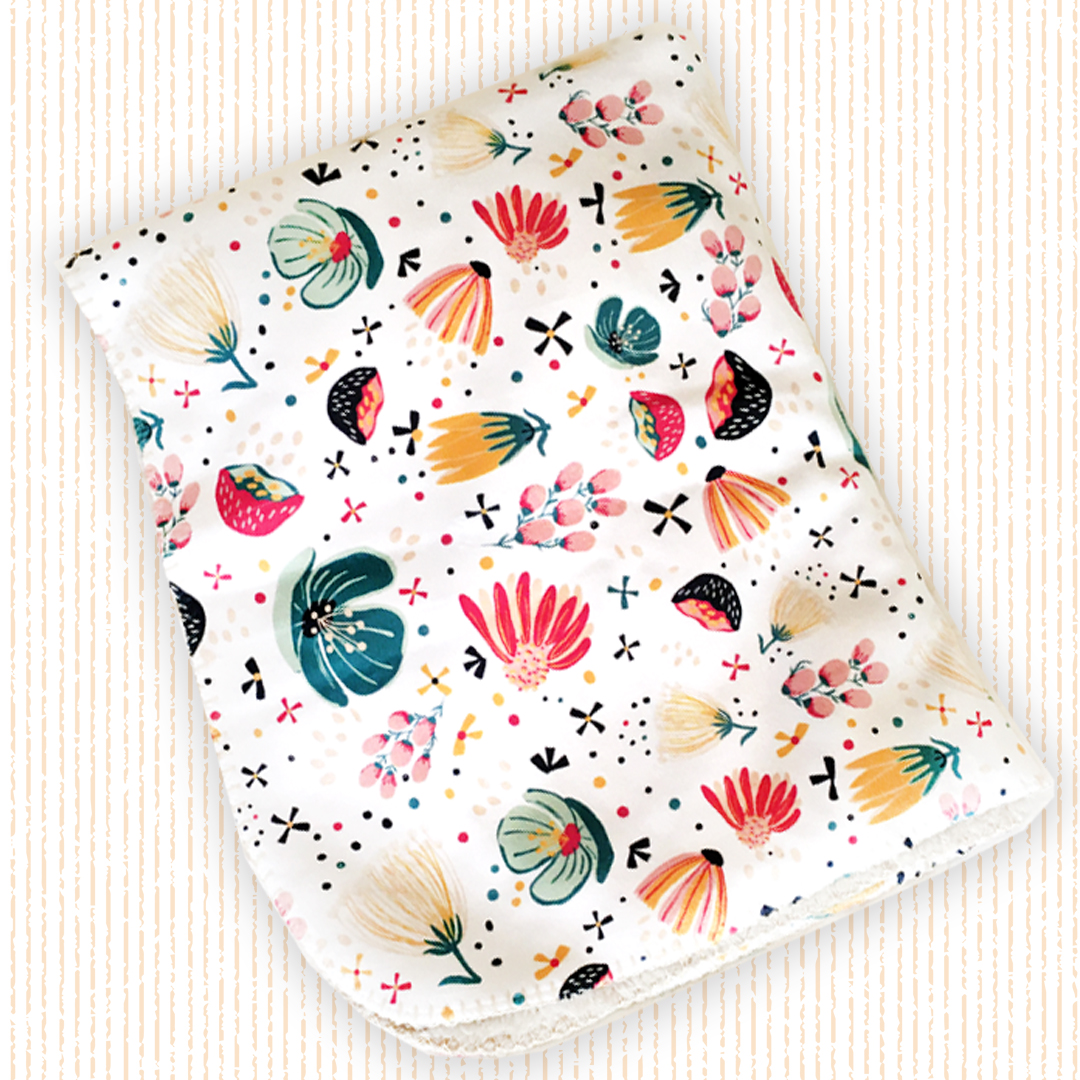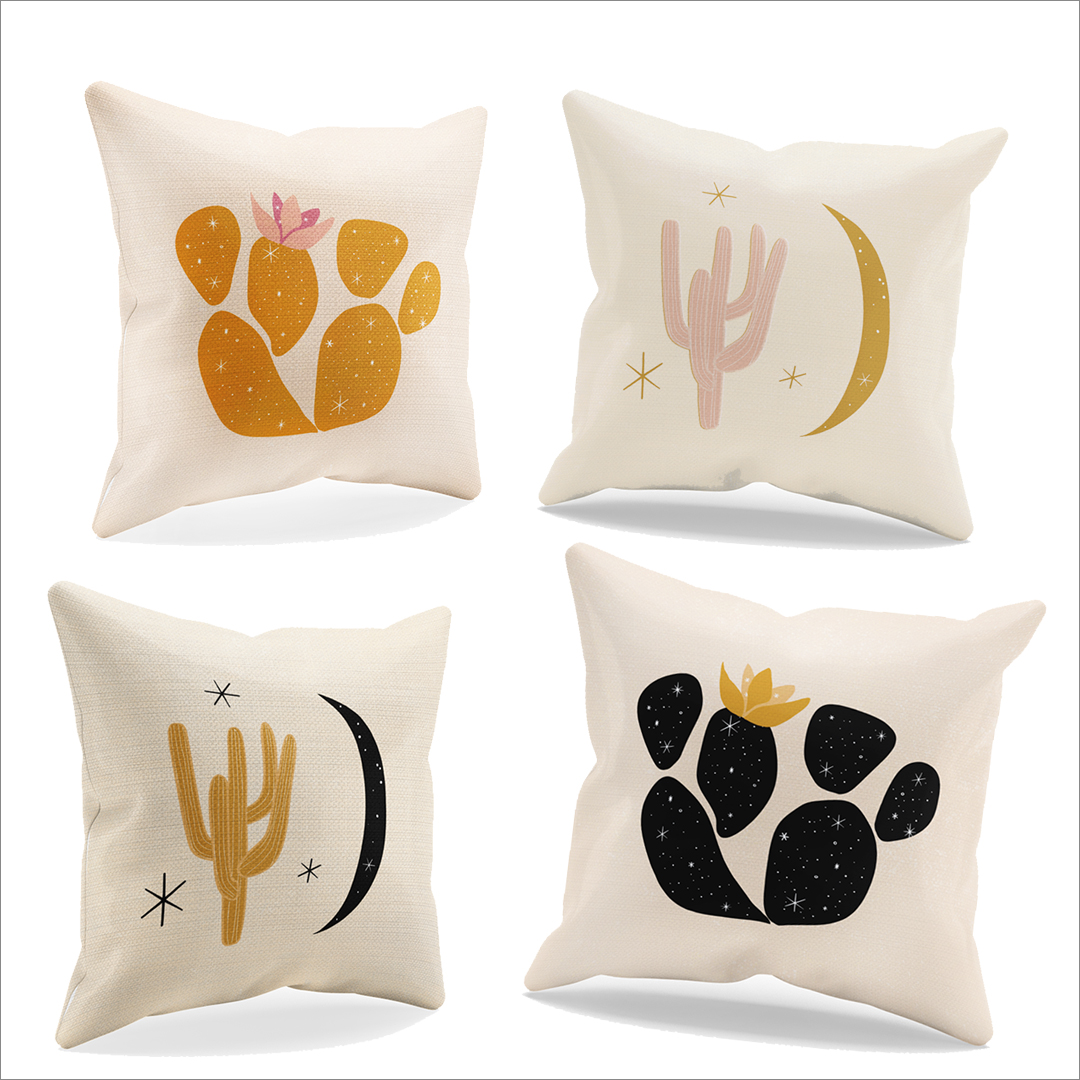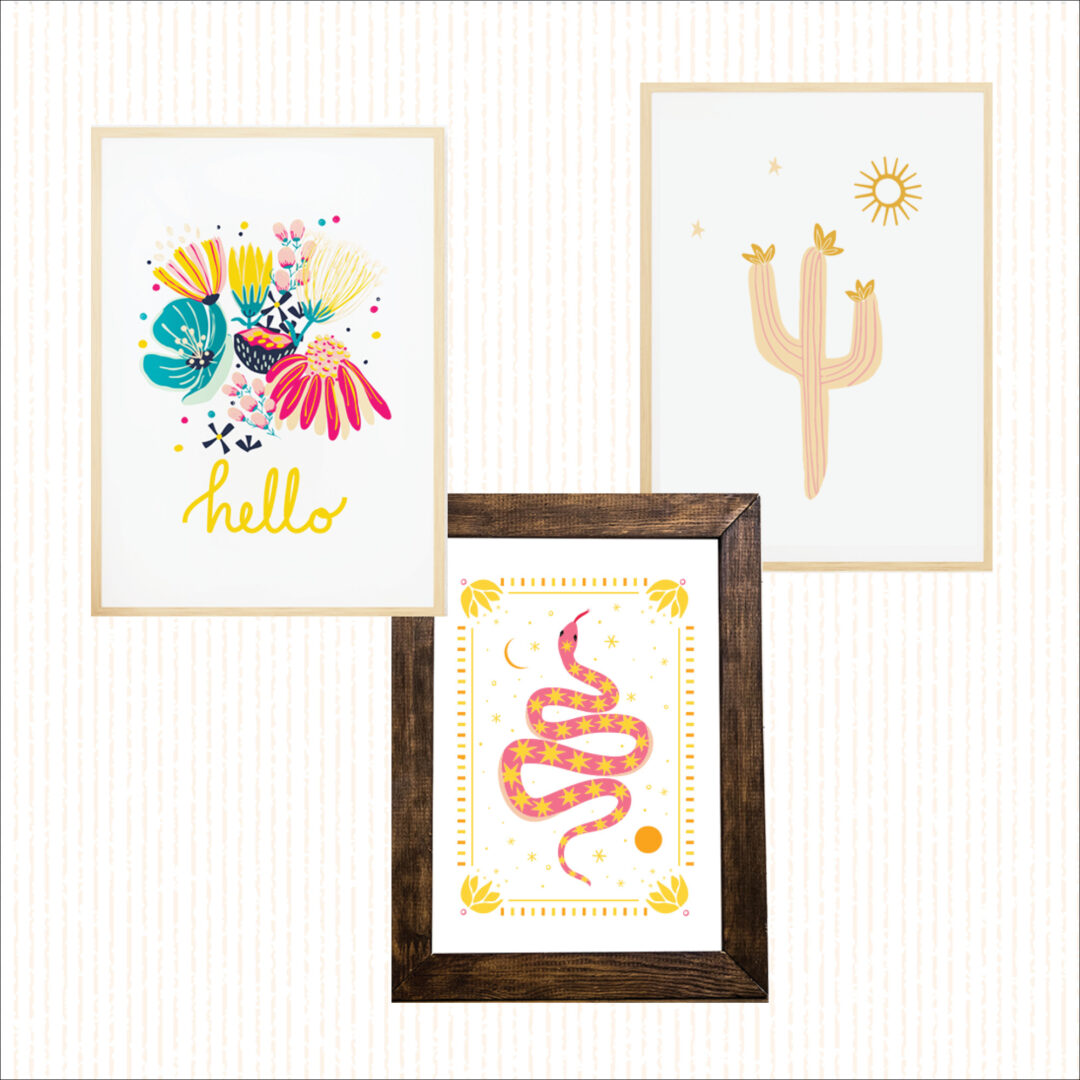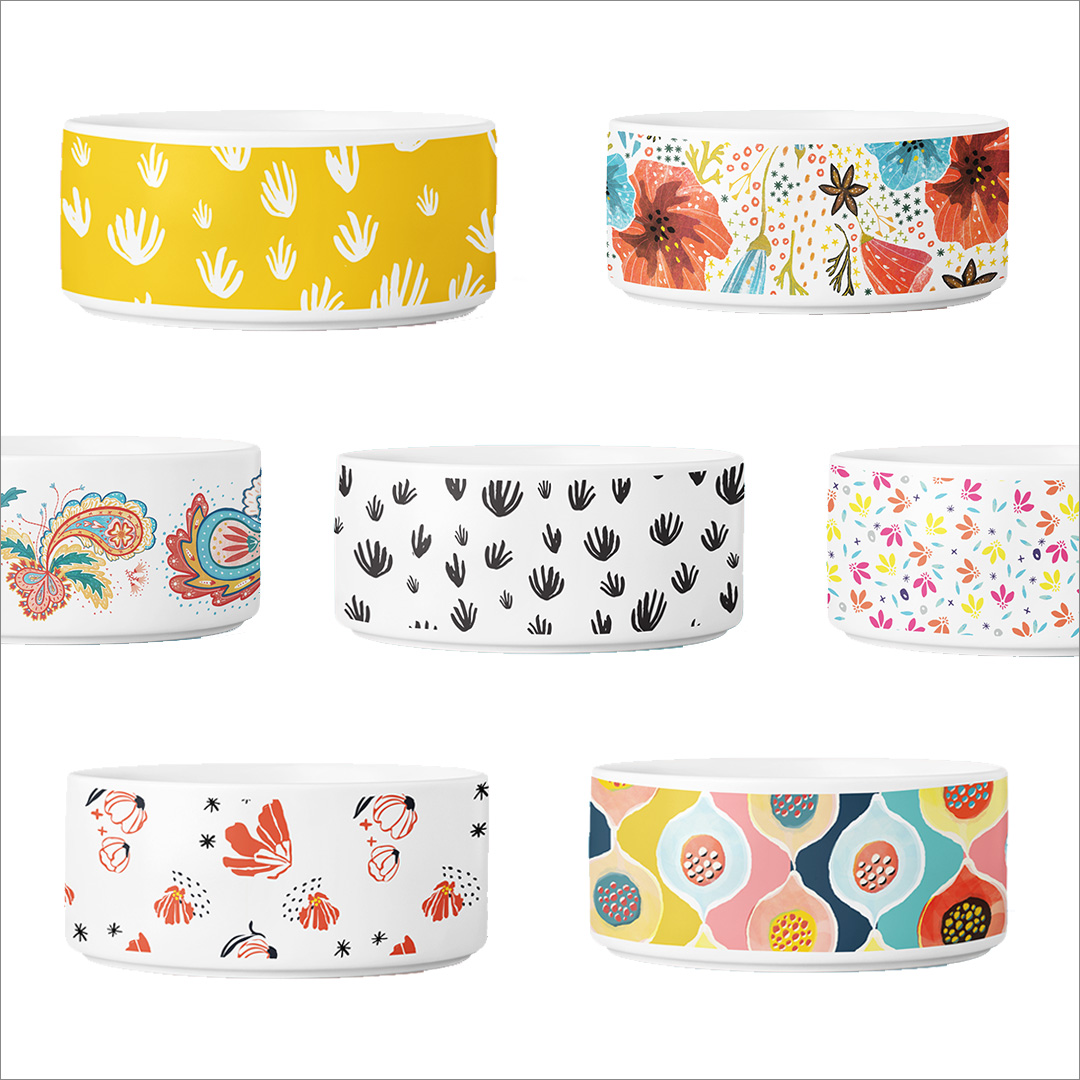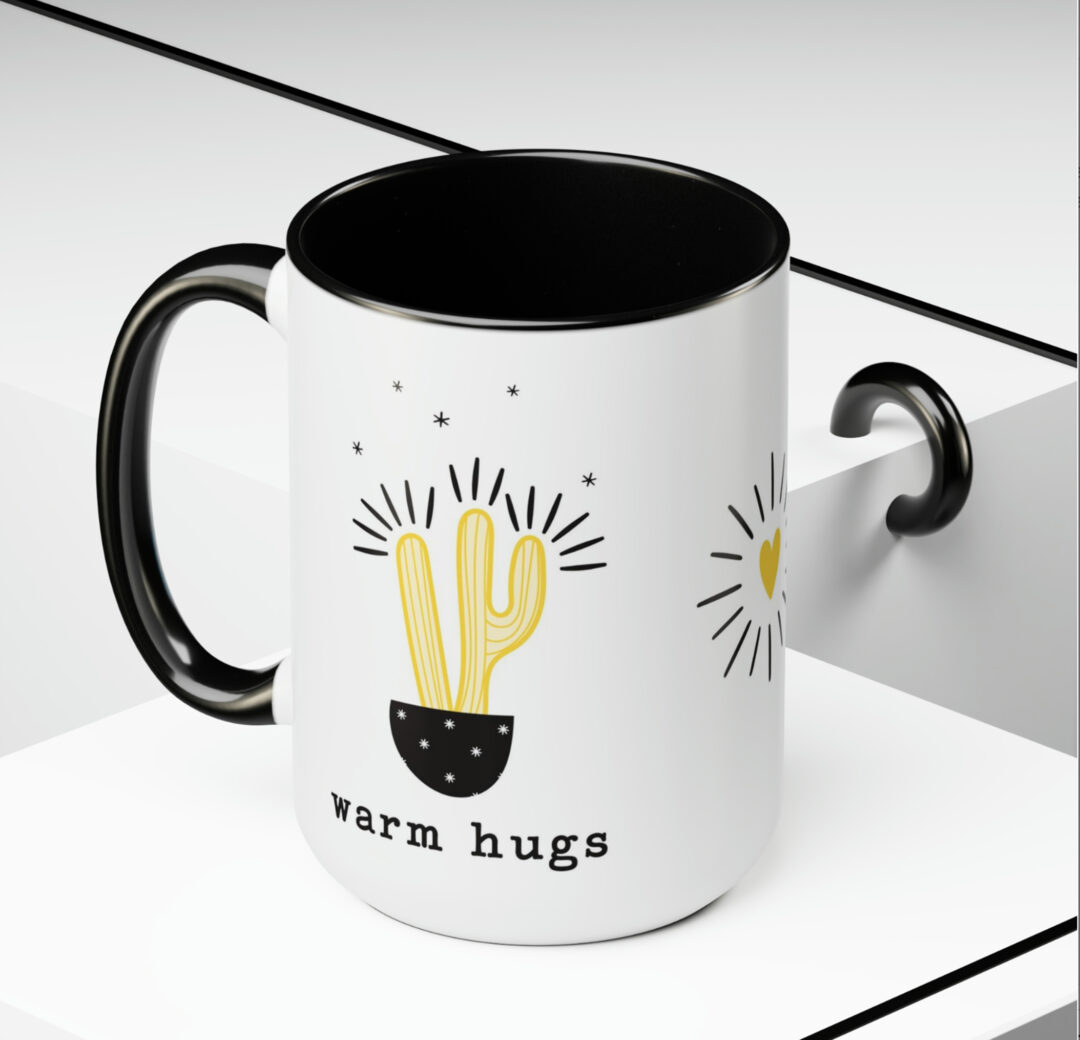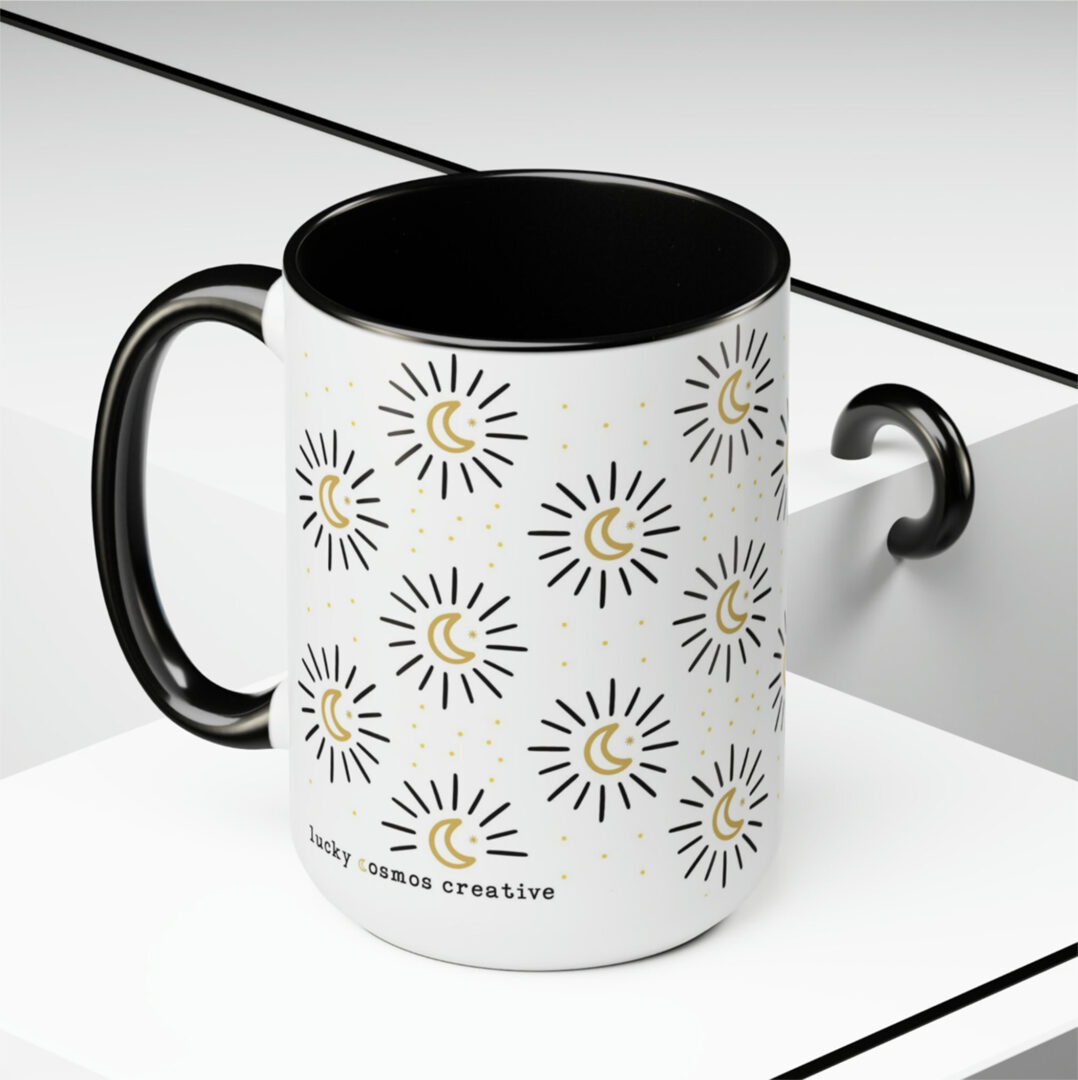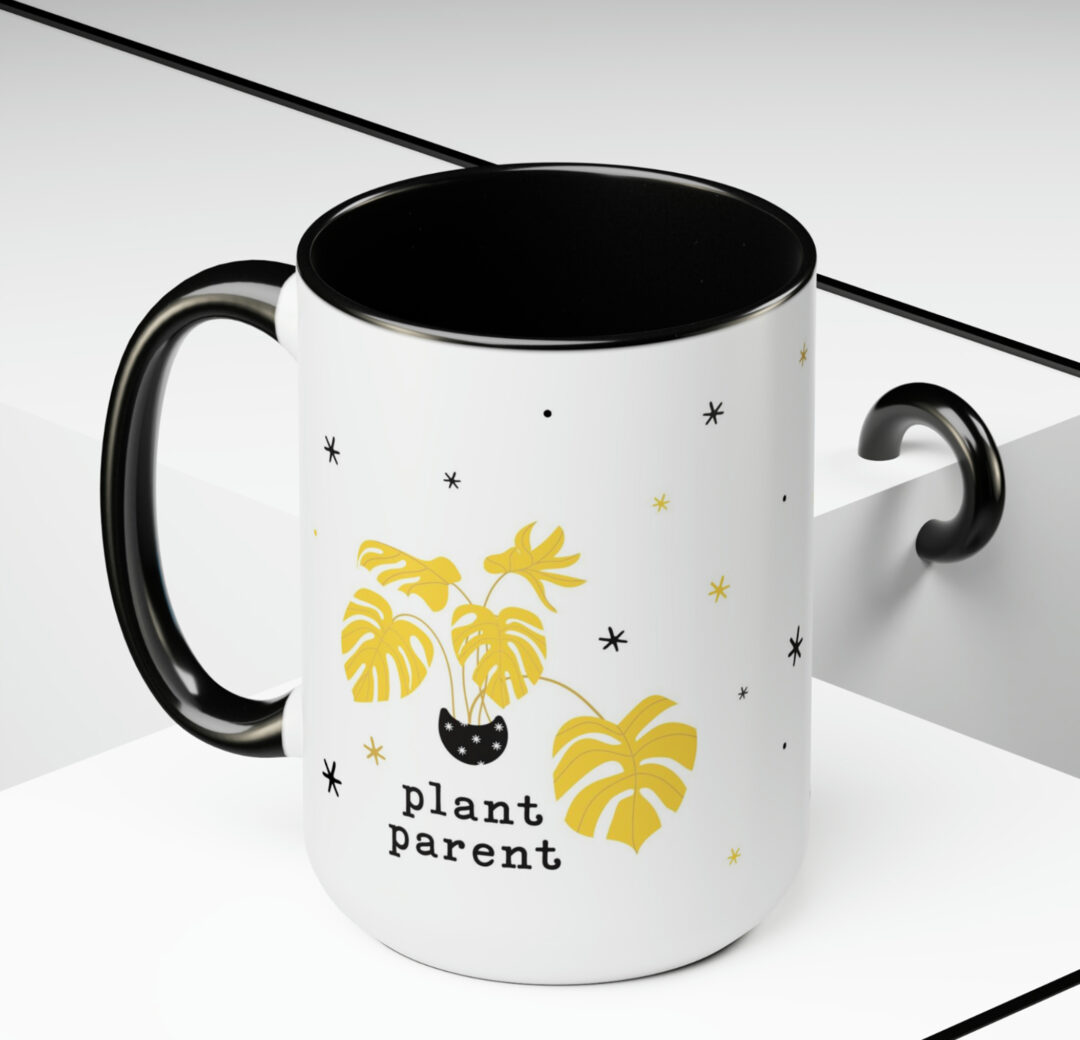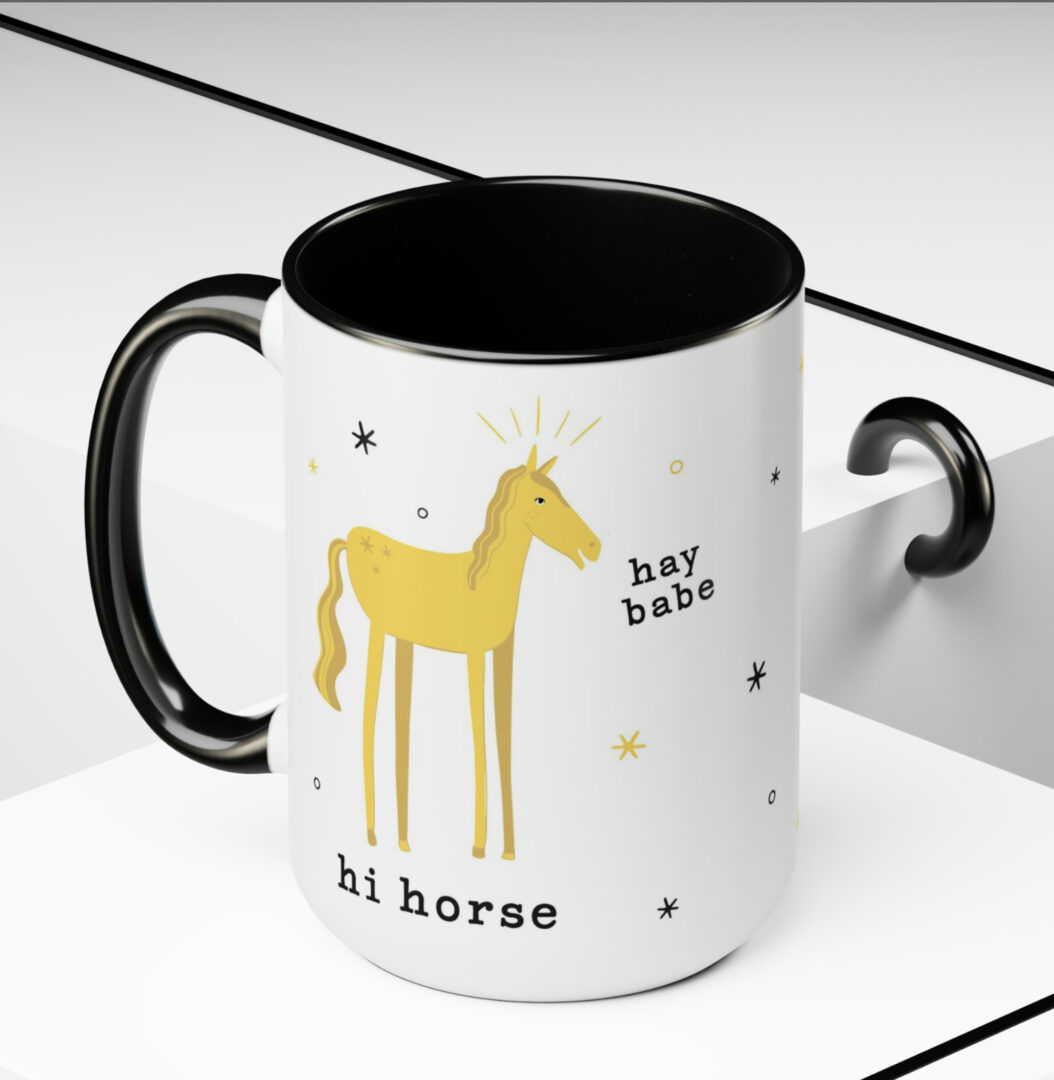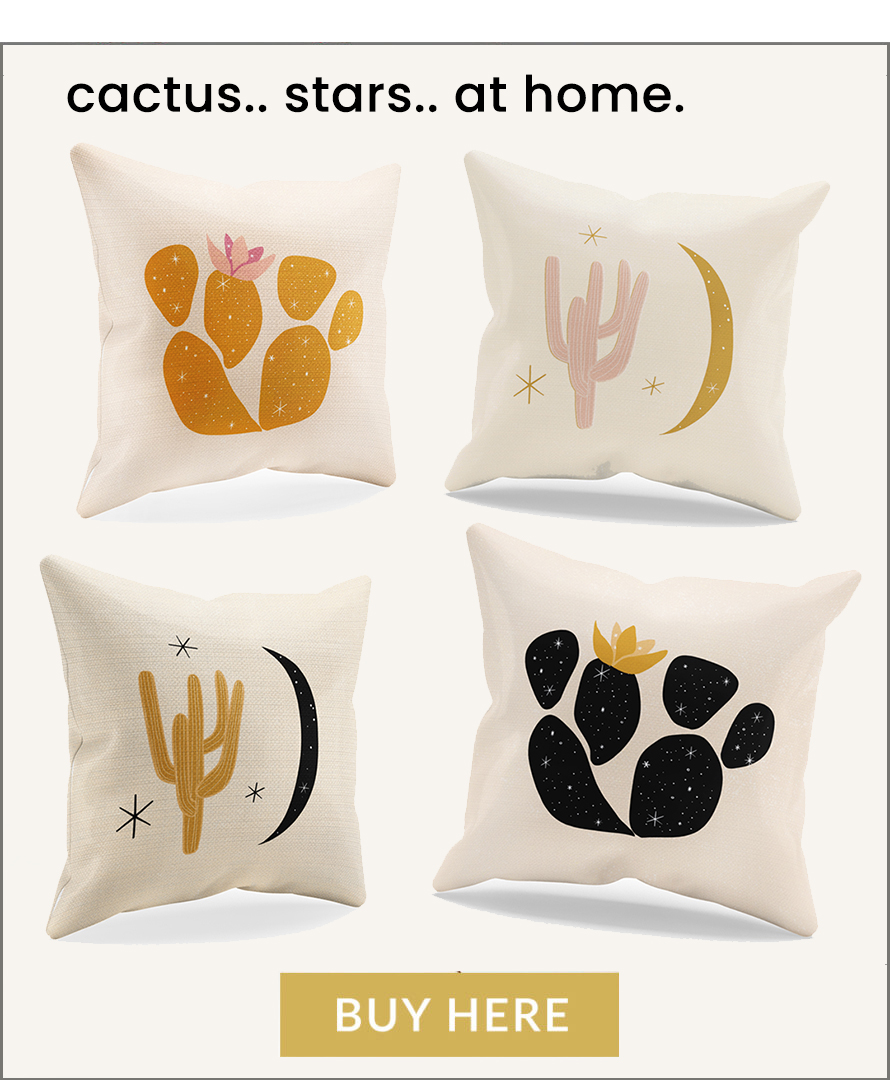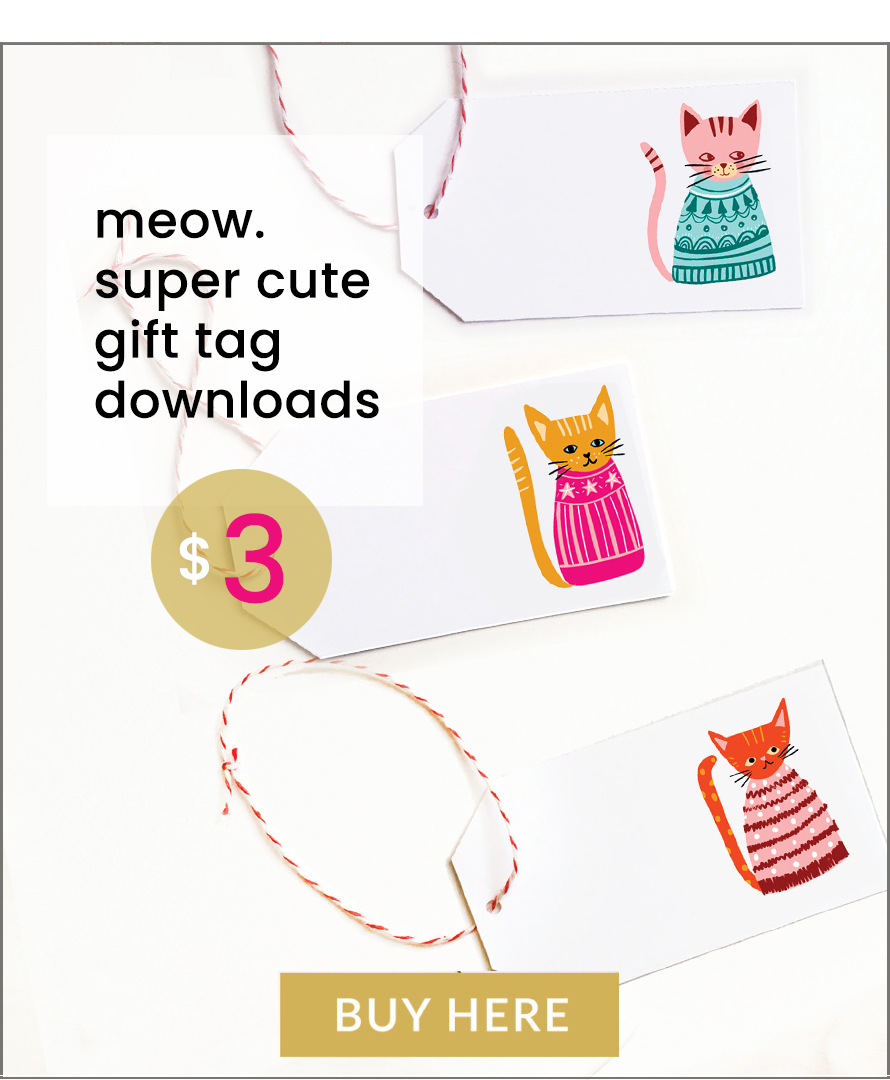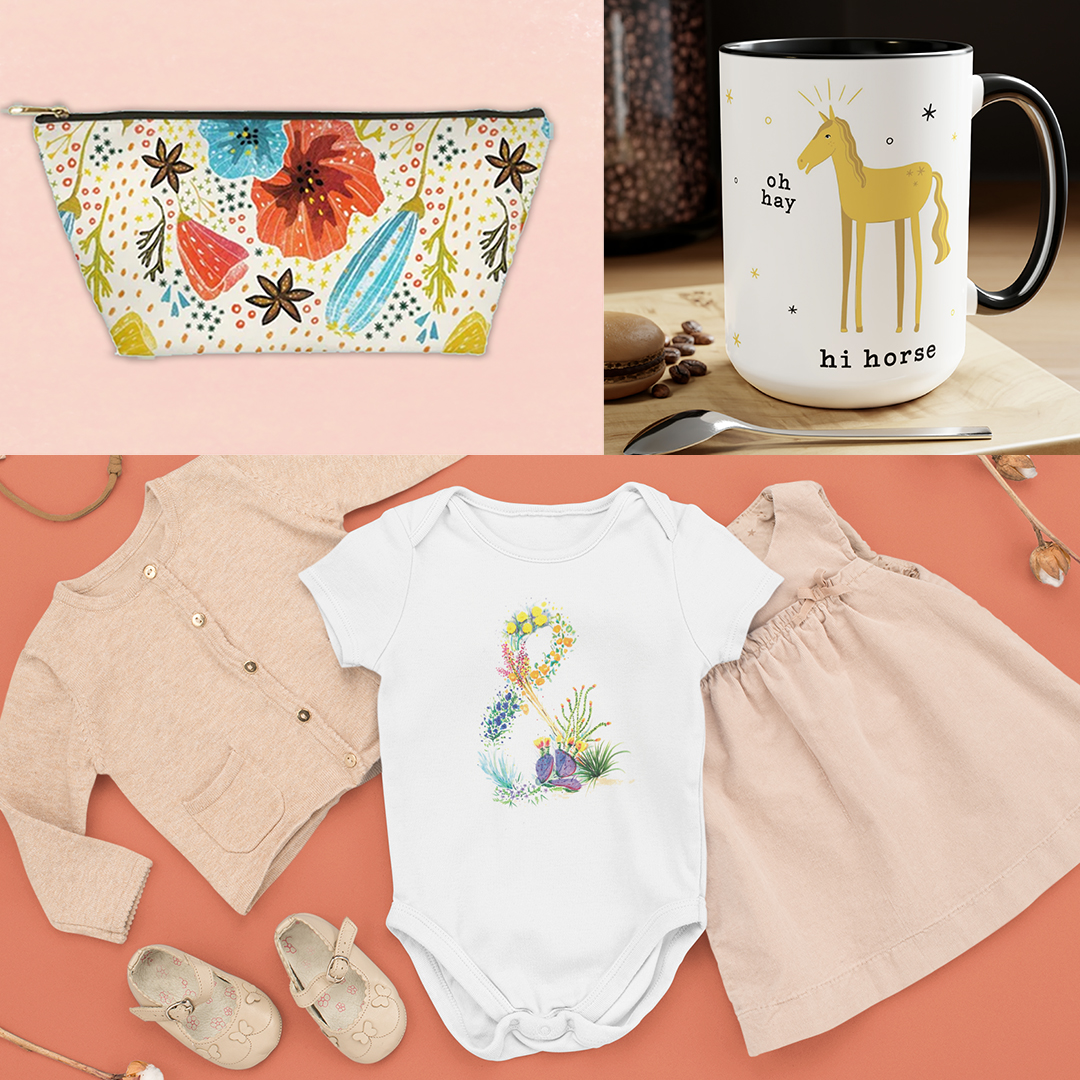
Do you dream of making your own products with your art on them?
Have you imagined seeing your art on a line of stationery or adorning fabrics, toys or mugs? Or maybe printed on fabrics as a collection of different patterns? It’s pretty fun to imagine creating your own products patterned with your art.
When I first became determined to experiment with making my own products (this was wayyy back in 2009), I got myself a Yudu screen printer, a few packs of wholesale blank shirts, totes, onesies, and tea towels, and I printed my own designs in my kitchen. I set up at local farmers markets and art markets and made a little extra cash. Here are a couple of my very first shirts…
I cherish this experience and learned so much about printing, messing up, and selling my products at little markets.. But I didn’t keep this up or build my own product lines in any real ways much after that. So, years later, when I wanted to dabble in making my own products again, I found that there were a ton more ways to do this.
Many artists like to create their own products by hand, some choose to print their art on blanks (like I did), and some prefer print on demand services (I’m dabbling in this now) that allow them to make products or product prototypes with their art on them without having to deal with the making and shipping of the actual goods.
So, where do you even start creating your own products?
First, you’ll want to ask yourself some questions to figure out what you want – what you really, really want. You’ll need to take yourself on a journey of questions like these:
- Do I have the bandwidth to make my own products? Am I making them to sell, gift or for promotional items?
- Do products and merchandise make sense with my business goals? Will they elevate my brand or help me get closer to building my dreams?
- Do I want to hand craft products, print my art on products, or manufacture products with my art?
- How will I create a workflow that helps me keep up once I start selling products?
- Are people buying the kinds of products I want to sell? Do I have a way to connect with them?
- Where will I sell my products? Online? In local retail shops or galleries?
- How long do I really want to “be involved” in the day to day production of my own products? Or do I even want to be involved in assembly, packing, or shipping at all?
- Do I have the upfront funding to make or manufacture my own products? Or is print on demand a better place for me to start, since I can’t invest bunches of money upfront?
There are maybe a million more questions you may think of to ask yourself. At some point you’ll likely find yourself in the intersection between analysis paralysis and taking a calculated risk if you really want to get into creating your own products.
Just try to get clear on how much time you’re willing to commit, what kind of financial investment you’re willing to make in the beginning, and where you plan to sell or pitch your products. Some artists find great joy in sewing their own unique pillows or toys to sell wholesale or consignment at retail shops and galleries where they have made connections.
Other artists may still choose the wholesale/consignment product route but maybe they make art prints, greeting cards and stickers that can be designed once and printed over and over.
And other artists don’t want to mess with having the inventory of physical products and choose to use a print on demand service to create products with their art for sale on their own website, or on Etsy or other art merchandise websites.
Selling your art products wholesale and retail
Making your own products and selling them in shops and stores was once the best way to get your products into the hands of those who want them. And it’s still a really viable way to sell products with your art on them.
Creating your own products to sell in storefronts means making connections and relationships with store owners and gallery managers, and following their guidelines for selling in their spaces. If you have samples of your products and find a place that would be the perfect market for them, try to schedule a short meeting with the manager or buyer so they can touch and feel your products – and meet you!
Relationships are your top priority when selling in retail shops, so be sure to follow through on your promises and respect the rules laid out for artists or vendors (for example, they may have a rule that your artwork can’t be sold in another shop or gallery in the same town).
Building these connections and growing the number of shops that will carry your products will help you to scale to sell more, so be sure you have a plan to scale and produce enough product for all of the places you sell.
Many, many artists really prefer this way of getting their art products out there because that feeling of community and small made goods is part of their values as an artist. they’re invested in sustainability, the creative process and imbuing their own creative energy into their products. Some of these artist also make and sell their physical products through online marketplaces also, so that’s where we’ll focus next.
Selling your artist made products online
Online. So big. What to do? If you have your own website, a humming newsletter schedule and a bit of a following, selling products from your own website may be a great idea for you. If you’re willing to learn the e-commerce engine to sell the merchandise and you already have an interested or invested audience, selling on your own site may also mean more profits for you. But it may not…
There’s also Etsy (probably the best website to sell custom products) and other art merchandise websites. These sites allow you to create a profile for your art business, and you do pay fees to list your products and sell them, but they are handling the e-commerce engine that allows people to purchase your products. And if you don’t already have a website, it may make sense to set up in one of these marketplaces where there are already millions or billions of people who are already shopping there.
Do keep in mind, you can really get lost in a sea of sellers, and if you don’t do some marketing and getting the word out, you may sit with a stagnant store stocked with super cute products splashed with your art. So find ways to share that you’ve got products out there whether you do this on social media, or you start growing your own newsletter (highly recommend).
While Etsy and other online marketplaces are great places to sell your artist crafted products, they’re also great places to sell art products that you have had manufactured with your art on them. Think tea towels, mugs, clothing, etc. So if you’re looking to scale and make a lot of products, read on to learn more about finding a manufacturing partner for your products.
Finding manufacturing partners for your art products
Okay – full disclosure, I have not done this. I’ve done the other things I’ve written about above, but this is not something I have personal experience with. So I’ll share what I would do if I was searching for the perfect manufacturing partner.
First – I’d come with a new list of questions:
- Are there manufacturers who will make smaller quantities for artists? Maybe quantities of 25 vs 100+?
- What is the price break at different quantities?
- Does this manufacturer also warehouse larger quantities of my products so I can order smaller batches I need when I need them? Or will all of the products be shipped to me for storage?
- Does this manufacturer do drop shipping so I can sell my products online and trigger the manufacturer to ship out a product when purchased?
- Is this manufacturer in my country of origin? If not, what are the pros and cons?
- Can I visit the facility, and is the customer service friendly and helpful? (I’m a newbie, I’d want someone patient enough to walk me through the process without being frustrated).
- Will the scaleability allow me more time and earn me more money?
I wish I could tell you more about how it really works to manufacture your own products. I’ll come back and update this post when I know. But if you’re really interested in this method of product creation, I’d start learning from artists who do manufacture their own products – they’ve fallen on their face and will likely share what not to do in addition to what may work for you.
Manufacturing products may be a great way for you to increase your product sales, and because you get the bulk discounts of ordering in higher quantities, you’ll have a much higher profit margin than you would with a print on demand service.
But. If the manufacturing process all sounds like wayyyy too huge of a commitment to delve into and you’d still like to have professional product makers develop your products with your art, you may be more of a print on demand artist.
Creating your own products using print on demand services
There are now quite a few print on demand services that will integrate with your website e-commerce system or Etsy to make product creation and shipping easier on you.
Print on demand works by allowing you to upload your art and patterns onto products that you choose, and then list those products in your online shop. So, when someone purchases your artist made mug, the print on demand company will be alerted. They will print your design on the mug, pack and ship it to your customer, and bill your credit card on file.
Print on demand allows you to have a robust product line without holding any inventory. You can choose to create print on demand T shirts, mugs, puzzles, bandanas, table cloths, pet products – there are honestly so many products you can make.
The downside to POD is that your profit margins are really low. That’s because the company who is making your product is doing one product at a time – on demand. They do all of the production and shipping work so you receive a small portion of the sale.
So if the printing company charges you $20 for the custom tumbler and you charge your customers $35, you’ll be paying the POD company $20, plus any Etsy listing or other fees. Sometimes the margin on a product is only around $2 or $3 per product. But if you’re really putting the time and marketing into your store (that’s a must) it may be totally worth it if you get a high quantity of sales.
Your part of the process of creating your own products will include creating and digitizing your art, uploading it onto your products, listing them in your shop (or Etsy), and marketing. If you’ve got a collection of art you think would look awesome on products, you can create a print on demand account, link it to an Etsy shop, and start selling products with very little upfront costs.
Also, print on demand services can help you simplify the process of how to make a product prototype. Maybe you’re preparing a pitch box to send to your ideal licensing client (I’m doing this now, I’ll let you know if it’s effective) and you want to include some samples of your artwork on products. You can print a single mug, bandana, baby bib, onesie or whatever, and include it in your pitch.
There are a lot of different things you can do with print on demand that allow you to showcase your placement art and patterns, so do a little exploration on whether this service may be of value to you as an artist, even if you aren’t interested in selling products.
And now that we’ve circled back to products.. I hope you enjoyed this glimpse into a few ways you could begin creating your own products, or maybe introduced some ideas of ways you can modify your current offerings. If you want to make products with your art, there’s a pathway for you. Wishing you product making success!
Other posts you may be interested in:
Awesome Custom Home Decor Art You Can Design Yourself
5 Powerful Business Branding Ideas to Build Your Brand Authentically
Making Art for Current Retail Trends.. The Pros and Cons of Designing for Trends
